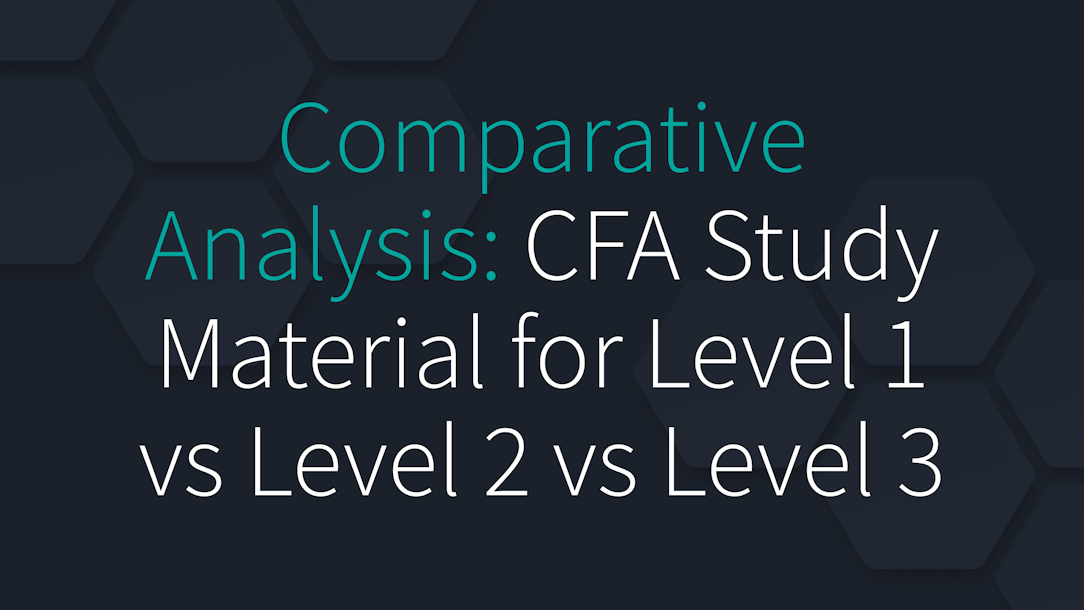
Comparative Analysis: CFA Study Material for Level 1 vs Level 2 vs Level 3
Each level of the CFA exam presents its unique challenges, and the study materials reflect these differences.
The CFA program is a rigorous path to becoming a Chartered Financial Analyst, with three distinct levels that test candidates' knowledge, application, and mastery of financial concepts. Each level of the exam is progressively more challenging, and understanding the differences in study materials is key to a successful preparation strategy.
In this article, we’ll explore the key differences between CFA study materials for Level 1, Level 2, and Level 3, helping you approach each exam with clarity and focus.
Level 1: Building the Foundation
Level 1 is all about the fundamentals. The exam focuses on the basics of finance, ethics, economics, and investment tools. The study materials for this level are broad in scope, covering a wide range of topics that are introduced at a relatively shallow depth. Candidates must familiarize themselves with the CFA curriculum's language, as much of Level 1 is about building the vocabulary and understanding the key principles that will be expanded upon in later levels.
Study materials for Level 1 typically include textbooks, video lectures, and flashcards. The emphasis here is on memorization and comprehension. Practice questions at this stage are mainly multiple-choice, making it essential to drill practice exams and quizzes to cement foundational knowledge. Flashcards and summary guides are popular resources because they help in retaining the large volume of information that needs to be absorbed.
Level 2: Deepening Analytical Skills
As you move into Level 2, the focus shifts from memorization to application. The study materials at this level dive much deeper into financial analysis, with an emphasis on valuation, equity analysis, and fixed income. The key difference from Level 1 is the depth at which each topic is explored. The breadth of material narrows slightly, but the intensity of each subject increases significantly.
Study guides for Level 2 are heavier in analytical content, with more emphasis on case studies and scenario-based questions. CFA Level 2 candidates must learn how to apply the concepts they studied in Level 1 to real-world situations, which makes practice exams crucial. Most study platforms offer mock exams that mimic the item set format used in Level 2. These item sets require candidates to read a vignette and then answer a series of related questions, testing both comprehension and application skills.
Level 3: Synthesizing and Applying Knowledge
Level 3 is where it all comes together. The final stage of the CFA exam focuses on portfolio management and wealth planning. Unlike Level 1, which tests your ability to remember facts, and Level 2, which assesses your analytical skills, Level 3 challenges you to synthesize everything you've learned and apply it to real-world portfolio management scenarios.
Study materials for Level 3 are a mix of detailed case studies, essays, and scenario-based questions that require strategic thinking. The curriculum is heavily focused on behavioral finance, risk management, and the creation of investment strategies. Essays (also known as constructed response questions) are a key component of Level 3, and mastering the essay format is crucial for success.
Candidates are advised to practice extensively using sample essay questions and feedback-oriented study tools.
Comparing Study Approaches
Each CFA level requires a different approach to studying. Level 1 is about mastering a wide range of concepts, so candidates benefit from frequent quizzing and the use of summary materials. Level 2, on the other hand, requires deeper engagement with financial analysis, so using detailed case studies and financial models is key. Finally, Level 3 is about mastering portfolio management and wealth strategies, making essay practice and real-world application critical.
Time commitment also varies across levels. Level 1 requires more hours spread across a broad range of topics, while Level 2 and Level 3 demand more focused, high-intensity study sessions. As you progress, it becomes increasingly important to allocate time for practice exams and simulated scenarios that mirror the exam format.
Conclusion
Each level of the CFA exam presents its unique challenges, and the study materials reflect these differences. Level 1 focuses on building a strong foundation, Level 2 deepens your analytical skills, and Level 3 tests your ability to apply knowledge in real-world scenarios. Understanding these distinctions can help you tailor your study approach to the specific demands of each exam.
At Salt Solutions, we provide comprehensive study materials tailored to each CFA exam level. Whether you’re just starting your Level 1 journey, deepening your knowledge for Level 2, or mastering portfolio management for Level 3, we’ve got you covered. Explore our CFA Study Material Guide to ensure you’re well-prepared at every stage of your CFA exam journey!